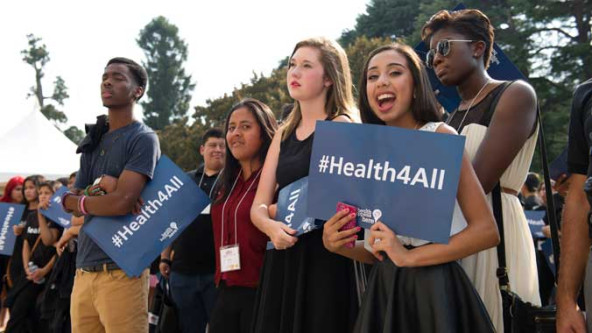 Youth Advocacy Day in Sacramento: The California Endowment’s partner organizations bring youth from across the state to speak to their state leaders about the issues impacting their health. (Image courtesy of The California Endowment)
Youth Advocacy Day in Sacramento: The California Endowment’s partner organizations bring youth from across the state to speak to their state leaders about the issues impacting their health. (Image courtesy of The California Endowment)
The connection between impact investing and our foundation’s commitment to advancing diversity, equity, and inclusion comes up for us every day at The California Endowment (The Endowment). As a health funder, we know race and structural racism drive health inequality and lifespan differences between communities, and we have emphasized the importance of diversity and racial equity in our work since our founding.
As we continue to deepen our commitment to these issues, we’re excited about the progress we have made through our investments. We are also reflective. Our history of working at the intersection of health and racial equity has taught us important lessons that influence how we put our capital to work, and continues to remind us of what more we need to do as we pursue our mission. Below are five core practices that have helped us make racial equity central to our impact investing work:

1. Set Concrete Goals for Accountability and Evaluate Progress
In 2008, The Endowment created a Diversity Equity and Inclusion Audit (DEI Audit) that laid out 15 goals related to diversity, equity, and inclusion. Since then, we’ve conducted additional, organization-wide audits of our DEI practices every few years, in partnership with the evaluation firm Social Policy Research Associates. The audits draw from a combination of interviews, document reviews, staff surveys, and grantee data.
Evaluating our practices has helped foster a culture of continuous reflection and improvement across all departments. For example, we set a goal to focus on socially responsible investments after the first audit, but after our 2013 audit, we realized we needed to do more to adequately cover the range of activities across our investment portfolio and program-related investments (PRIs). We recognized we needed to set even more goals if we were to capture our full intent and the nuances of DEI work in our investments. As of 2016, we created specific goals for our PRIs and investments in our DEI Audit.
2. Make Intent Explicit in Investment Policy Statements
We have also made our commitment to DEI explicit within our Investment Policy Statement (IPS), which governs how we invest our endowment.
In 2017, we updated our IPS to include five DEI goals, including the inclusion of women and minority-owned firms in our investment portfolio; partnering with investment managers who incorporate environmental, social and governance (ESG) into their practices; and assessing and implementing investment screening to ensure that potential investments align with our mission and values. Today, 30 percent of our $3.5 billion endowment is with investment managers who incorporate ESG principals into their processes, and nearly $295 million of that portfolio is with women and minority managers.
Since 2015, The Endowment’s PRI Policy Statement, which governs our PRIs, has also included language focused on advancing DEI, and is structured to tie to our founding vision and mission. We incorporate DEI in our PRI due diligence and monitoring processes, and have started to collect data from our borrowers about the composition of their management teams and boards, as well as their internal policies and practices. So far, we have invested nearly $100 million in PRIs that support greater access to health services, fresh foods, affordable housing, and responsible financial services among all populations in the state of California.
675x380_-_28de80_-_dabaff770eb7b60b1e27a01587ea8e2e7dc4250b.jpg) Mandela Partners’ staff in front of a community produce stand in East Oakland. Mandela Partners, a California FreshWorks client, works in partnership with local residents, family farmers, and community-based businesses to improve health, create wealth, and build assets through local food enterprises in low-income communities. (Photo by Andrew Pau)
Mandela Partners’ staff in front of a community produce stand in East Oakland. Mandela Partners, a California FreshWorks client, works in partnership with local residents, family farmers, and community-based businesses to improve health, create wealth, and build assets through local food enterprises in low-income communities. (Photo by Andrew Pau)
3. Use Organization-Wide Commitments to Support Impact Investing
The Endowment’s organization-wide commitments have resulted in an ongoing dialogue about DEI and investing with our board. This has contributed to the implementation of three “negative screens” that we apply to our portfolio in order to prohibit certain investments that don’t align with our mission and commitment to racial equity, healing, and wellness. In the late 1990s, for example, our founding board implemented a tobacco screen, instructing that we not invest in tobacco companies. In 2015, after listening to grantees and other community leaders about the impact of hyper-incarceration on negative health outcomes and its disproportionate impact on communities of color, we added a second negative screen instructing that we not invest in for-profit prisons.
In the aftermath of the 2018 shootings at Marjory Stoneman Douglas High School in Parkland, Florida, we added a third negative screen that prohibits investments in companies that manufacture firearms. There were several reasons for this decision, but paramount was the disproportionate impact of gun violence in America on black and brown young people. What was both surprising—though ultimately not surprising—was how quickly our board and executive team reached this decision. In hindsight, it was only possible to move so quickly because The Endowment had already made an organizational commitment to and fostered a culture of addressing racial equity and DEI.
4. Support Values-Aligned Partners
One of our big responsibilities as a foundation is finding and supporting the development of mission-aligned partners, and our partnership with Northern California Community Loan Fund (NCCLF) offers a good example of how we’ve used PRIs to advance racial and economic equity.
When NCCLF was established in 1987, its founders had a vision of confronting economic and racial inequity in historically disinvested communities throughout Northern and Central California. Since making our first $2 million PRI to NCCLF, we have been tracking its deepening commitment to economic justice and racial equity, and we were excited when, in 2018, NCCLF’s strategic plan identified racial and economic equity as an explicit value and goal. Making this goal explicit indicated the organization’s desire to be more internally and externally accountable to addressing racial inequity within investments.
Catherine Howard, NCCLF director of strategic initiatives, described the motivation behind the goal this way: “Our early experience financing affordable housing development exposed us to the discriminatory dynamics that keep low-income communities from accessing adequate capital. We wanted to make sure that our strategic priorities going forward truly confronted these practices and held us accountable to the communities we serve. At the same time, we also wanted to hold ourselves accountable by developing our internal practices with a racial equity lens.”
Our strong alignment in mission and values has led us to support NCCLF with more than $10 million in PRIs and grants. We have also brought them on as the manager of FreshWorks, an initiative incubated in partnership with other foundations that focuses on expanding healthy food access in all communities, and particularly communities of color.
5. Prepare for Complex Answers to Difficult Questions
As we look to the future, we find ourselves grappling with next steps. One of the challenges to increasing our investments with women and minority-owned investment firms, for example, is that only a relatively limited number of these firms have access to institutional investors. As a health funder, does The Endowment have a role in building this field? How do we develop that capacity effectively while remaining true to our mission and the endowment’s investment policy?
On the PRI side, while we collect a tremendous amount of data, we need to standardize our process and questions. We need to learn how to make meaning of that data to shape and improve what we do. We also need to determine our role in supporting the field and our borrowers in furthering their own racial equity and diversity and inclusion goals and practices.
We have much to learn from the communities we serve and our partners. Brokering the marriage between impact investing, and racial equity and inclusion is certainly the right and smart thing to do, and we look forward to sharing strategies and approaches about how to get it done.
Support SSIR’s coverage of cross-sector solutions to global challenges.
Help us further the reach of innovative ideas. Donate today.
Read more stories by Amy Chung & Robert K. Ross.

